Userpilot vs Product Fruits: Which is Best for Your SaaS?
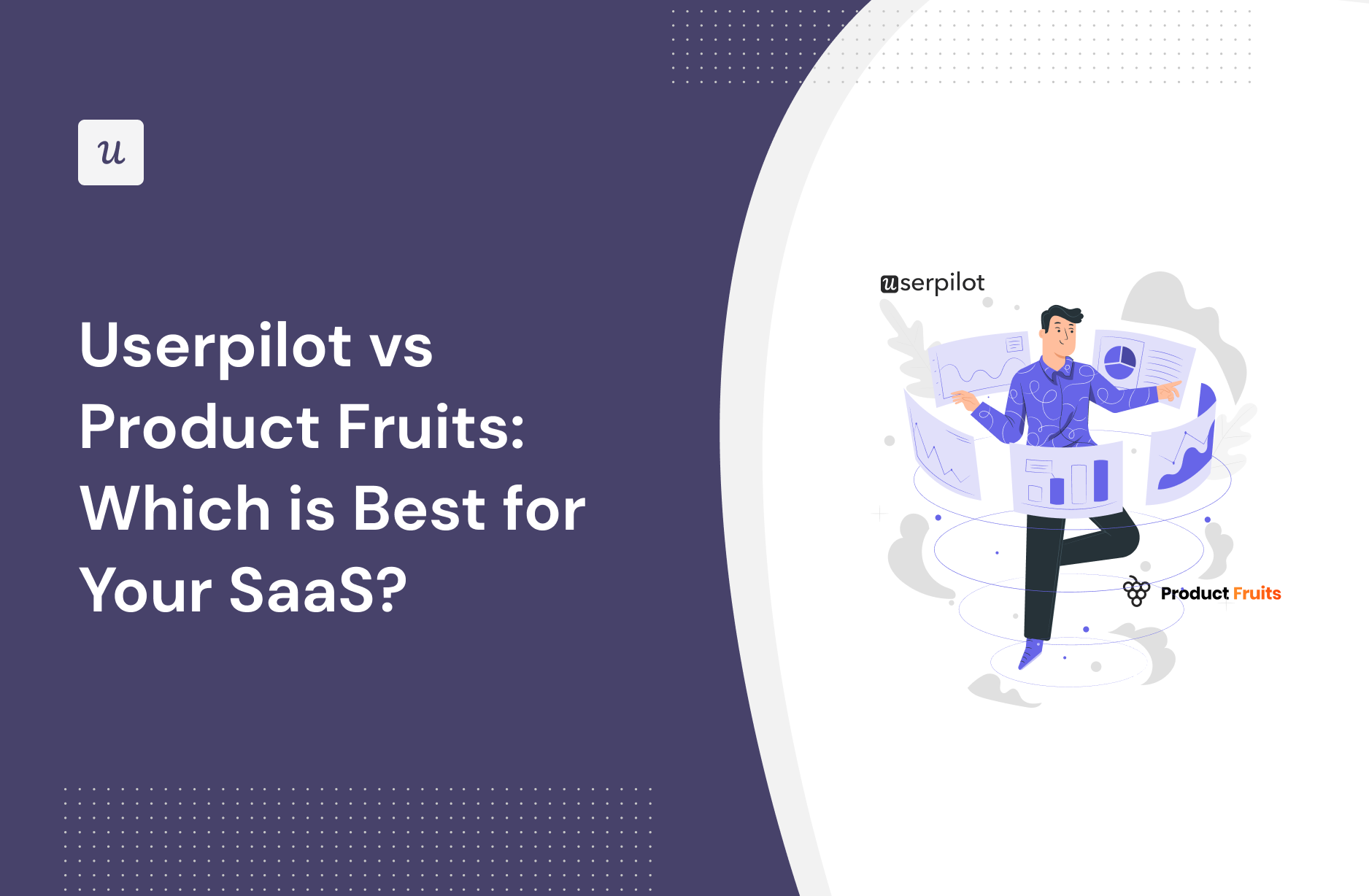
Wondering whether Userpilot or Product Fruits is the best option for your SaaS company?
This article is going to dive into the Userpilot vs Product Fruits debate and try to answer a key question: Which is the better tool for user onboarding, as well as other use cases?
In the post below, we’ve covered all the common use cases and done an in-depth analysis of the key features of Userpilot and Product Fruits – as well as explaining which one is better in certain cases.
Let’s get into it!
TL;DR
- Let’s explore how Userpilot, and Product Fruits compare when it comes to user onboarding and other common use cases.
- Userpilot is a product growth platform that drives user activation, feature adoption, and expansion revenue. It also helps product teams collect user feedback, streamline onboarding, and gather actionable insights from analytics.
- Product Fruits is a platform designed to help you tackle issues related to software adoption. With a focus on seamless customer onboarding, this tool allows companies to create engaging in-app journeys.
- However, in certain situations, while both Userpilot and Product Fruits offer commendable user experience and engagement, Userpilot tends to shine a bit brighter in several key areas. Here’s why:
- A/B testing: Data-driven decisions, customer engagement, and conversion rate optimization are all outcomes of effective A/B testing. While Product Fruits leverages Google Optimize for its A/B testing, Userpilot integrates this functionality directly within the app. This approach not only simplifies the process but also enhances accessibility.
- Tailored checklists and knowledge base: Userpilot allows users to create customized checklists and knowledge bases. These can be tailored to different customer segments and stages in the customer journey. This offers a depth of personalization that Product Fruits lacks.
- Advanced Segmentation: Userpilot allows you to build multi-language flows using its AI-powered translation service, and there’s no limit on the number of users you can segment. It allows for more effective feedback collection through trigger surveys tied to user journey milestones, and NPS surveys for measuring product sentiment. You can also track how users are behaving within the app and group them accordingly. So, if someone hasn’t completed their onboarding, you can send a personalized in-app message to help them along. While Product Fruits provides basic user-specific segmentation, it lacks the comprehensive and contextual capabilities of Userpilot.
- Integrations: Both Product Fruits and Userpilot offer 9 integrations. Although, they do share some common integrations like Intercom, Mixpanel, and HubSpot. However, the integration of Slack and Userpilot is currently under development. Most integrated products within the same category carry out similar tasks, no matter what specific tool you opt for. For example, Userpilot has an in-app integrated product analytics tool, unlike Product Fruits. This tool boasts features similar to those found in other tools, like graph and funnel creation, and more.
- Advanced analytics: In the realm of analytics, Userpilot truly stands out. You’ll be able to deeply understand user behavior and sentiment, without fussing over coding or API calls. Your selected features can be tagged for precise tracking, no dev team is required. Curious about user actions like button clicks or purchases? Userpilot’s heatmap offers insight into your users’ most and least interacted areas. Unlike Product Fruits, Userpilot lets you monitor your checklists’ effectiveness live, transforming raw data into actionable insights.
- Get a Userpilot demo for user onboarding and drive your product growth code-free.
![]()
Userpilot – A Better Alternative for Your SaaS

What is Userpilot?
Userpilot is a product growth platform that drives user activation, feature adoption, and expansion revenue. It also helps product teams collect user feedback, streamline onboarding, and gather actionable insights from analytics.

With Userpilot, you’ll be able to track both product usage and user behavior to get a holistic view of how customers use your product — which will guide future development, improve the user experience, and inform your growth efforts.
What is Product Fruits?
Product Fruits is a platform designed to help you tackle issues related to software adoption. With a focus on seamless customer onboarding, this tool allows companies to create engaging in-app journeys.
The platform provides insights into successful practices, guiding you toward steady business growth. Best of all, you don’t need any coding skills to get started with Product Fruits.
Userpilot vs Product Fruits for user onboarding
In this section of the article, we’re really going to compare Userpilot vs Product Fruits in terms of user onboarding. That way, we’ll be able to figure out which tool – Userpilot or Product Fruits – is the best option depending on your use case.
Userpilot for user onboarding
User onboarding is a crucial part of the customer journey as it speeds up the adoption process and increases retention rates. Onboarding is one of Userpilot’s core use cases along with product growth analytics and user feedback, so it has plenty of features that you can utilize.
Here are some Userpilot features you can use when onboarding new users:
- No-code builder: Creating flows with Userpilot is as simple as installing the Chrome extension, selecting the UI patterns you’d like to use, and then editing the content/settings to suit your use case. You can also use templates to create modals, slideouts, tooltips, and driven actions.

- Native tooltips: Userpilot lets you create native tooltips that show up when users hover over an element or click on an information badge. Since these native tooltips attach to the element itself, they aren’t page-dependent and will show up on any screen where that element is visible.

- Funnel analytics: Userpilot’s advanced analytics lets you create funnel reports that track the onboarding journey. You can also add filters (like name, user ID, signup date, operating system, country, etc.) and monitor the total conversion rate from the first step of the funnel to the last.
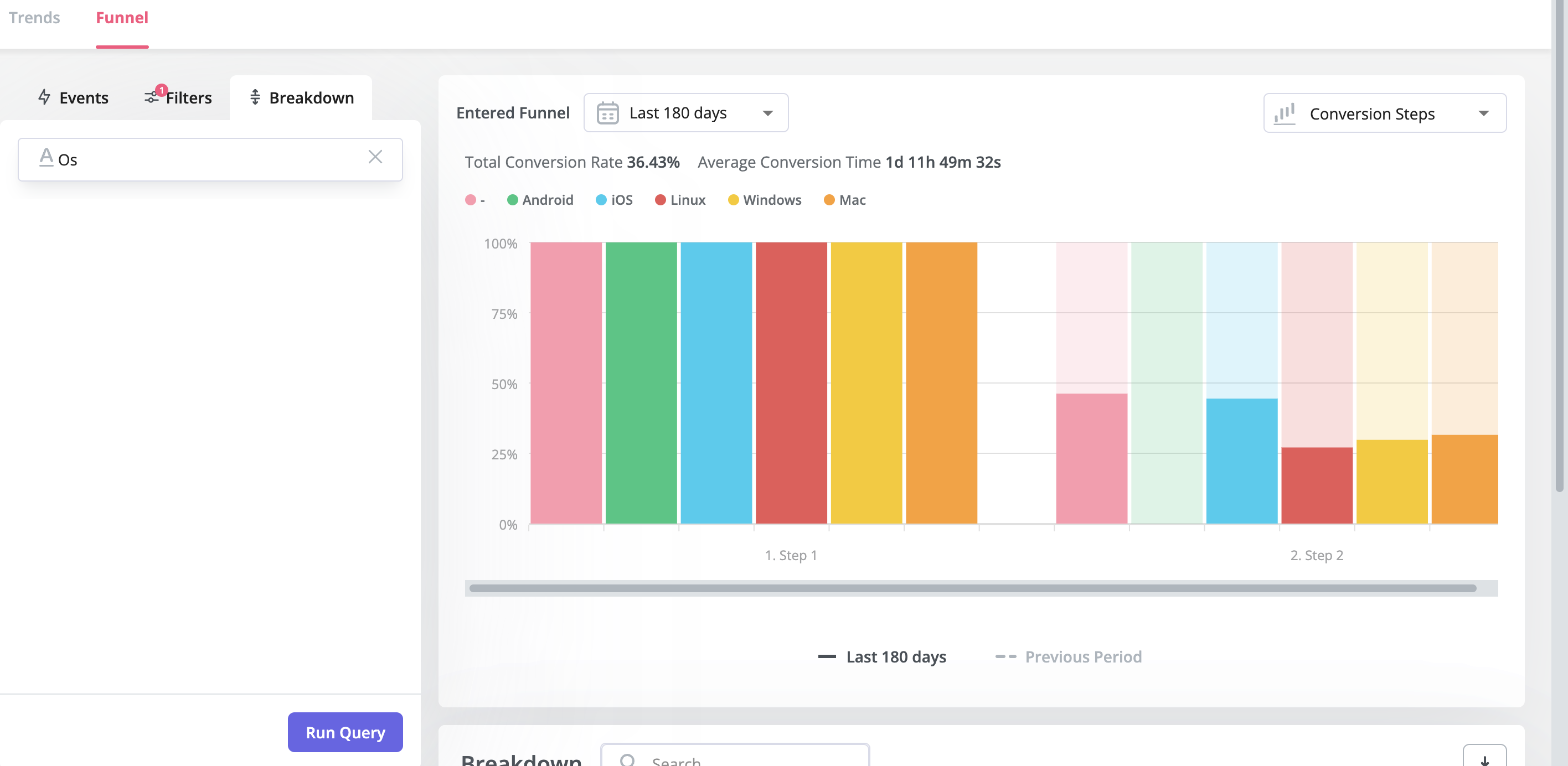
- User segmentation: Userpilot lets you segment users based on the device they’re using, where they’re located, their engagement data, or which NPS rating they selected on the latest survey. You can then filter your analytics dashboards to see which segments struggle with onboarding.

Product Fruits for user onboarding
If you’re looking for a tool to simplify your user onboarding process, Product Fruits can be your go-to. This software teaches your customers the ins and outs of your product. Moreover, its affordability makes it an appealing choice for budget-conscious small startups.
Here’s why Product Fruits can shine in your onboarding toolkit:
- Product Tours: Product Tours are a great way to welcome and introduce new users to your product. With Product Fruits you can craft step-by-step guides and embed videos from YouTube or Vimeo for interactive understanding. You can create cards that highlight your unique selling propositions to generate excitement. Additionally, the tours offer the option for users to initiate further exploration via a hint icon or special button. Want insights of your product tour? Use Product Fruits Analytics features. It offers data on user interactions, completion rates, time spent, and more, helping you fine-tune your tours.
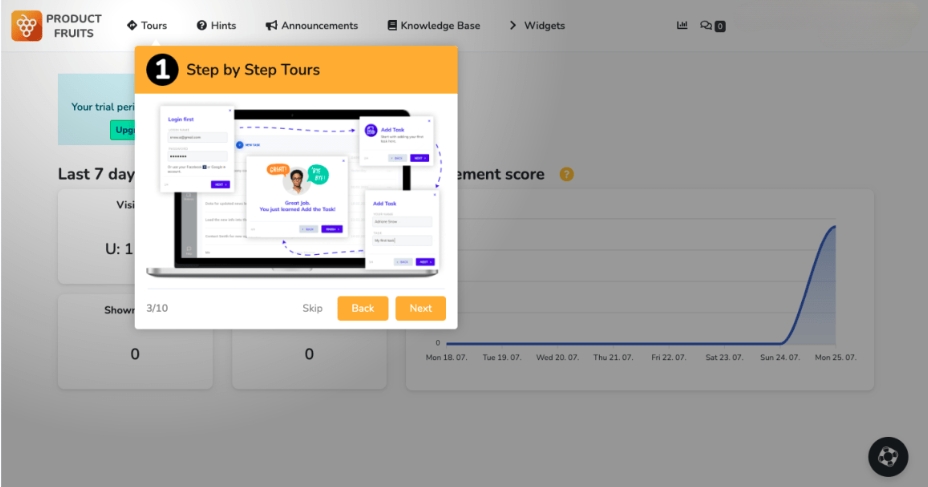
- In-app Announcements: Product Fruits uses pop-ups that appear over all other content, ensuring that users will see these messages before product tours. These pop-ups can be utilized for one-time announcements and are considered one of the best ways to share promotional content. Alongside pop-ups, Product Fruits offers a newsfeed feature. It lets you publish updates about your product in various formats. The newsfeed widget can be embedded into your application and will appear when a user clicks on an icon. A common practice is to use a bell icon accompanied by a badge showing the number of unread newsfeed items.
- Knowledge Base: This constitutes a database of information that users can use for assistance at any time. It simplifies article version management, allowing you to create work-in-progress versions and publish updates to production without altering the URL. Moreover, it’s possible to launch your help center on a personalized domain and integrate it into the structure of your website. The Life Ring Button allows users to directly access your web-based application’s knowledge base from anywhere on your product. And the best part? You don’t need any coding to do that.

Userpilot vs Product Fruits for product adoption
In this section of the article, we’re really going to compare Userpilot vs Product Fruits in terms of product adoption. That way, we’ll be able to figure out which tool – Userpilot or Product Fruits – is the best option depending on your use case.
Userpilot for product adoption
Product adoption is when users become repeat users of your product. It covers the entire journey spanning from the awareness stage to trial signup and finally full-on adoption. As a product growth platform, Userpilot has advanced analytics capabilities for tracking adoption over time.
Here are the Userpilot features that can help you measure and improve product adoption:
- Product analytics: Userpilot lets you create trend reports to track adoption over time by feature or segment, funnel reports that show you which steps of the process most users get stuck on, and integrations with third-party analytics providers so you can sync data between tools.
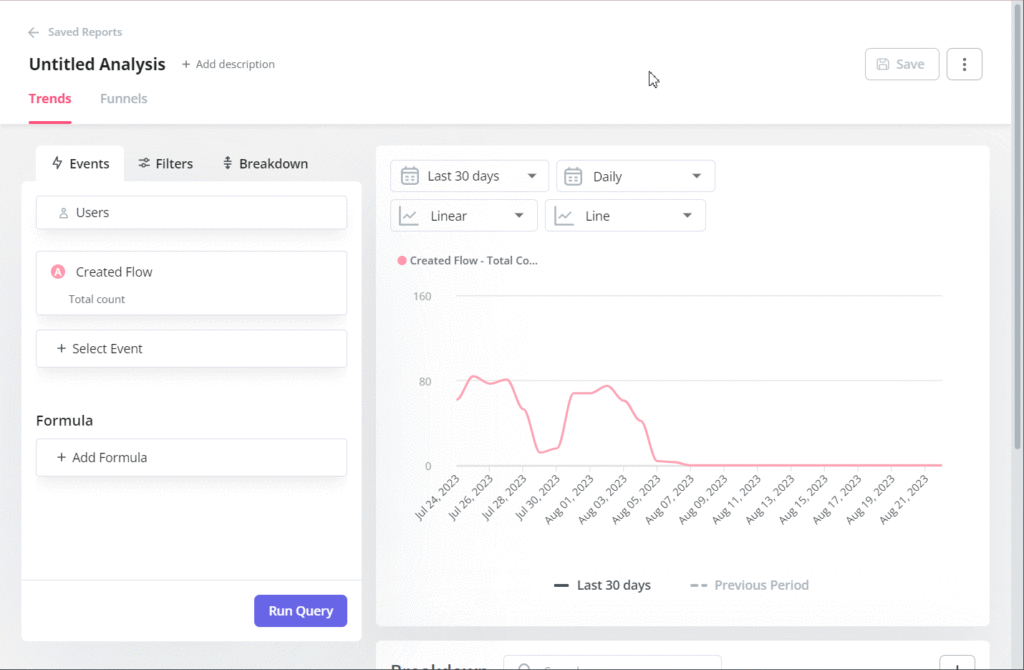
- Product usage dashboard: It collects all your key product usage metrics automatically without you having to set anything up: your Daily, Monthly, and Weekly Active Users and Companies, Trends of Active Users and Companies over time, user stickiness, top pages, features, and events, as well as the most engaged users, highest user activity times throughout the day, user retention, average session duration and product usage by browser.

- Feature engagement: Userpilot’s click-to-track feature tagger lets you see how often a feature is used and by how many people. You’ll also be able to see the top 20 events for a certain time period or create custom events that group multiple features together for clearer insights.

- Feedback collection: Userpilot has a no-code survey builder with 14 templates to choose from. You’ll be able to collect quantitative data like CSAT, CES, or NPS ratings and qualitative feedback on the strongest/weakest parts of your product straight from your users.

- User insights: The Insights dashboard lets you monitor user activity based on which segment they’re in and which company they’re from. You’ll also be able to choose from daily, weekly, and monthly time periods to see if user activity is shifting towards full product adoption over time.

Product Fruits for product adoption
If you’re looking for a tool to simplify your user onboarding process, Product Fruits can be your go-to. This software teaches your customers the ins and outs of your product. Moreover, its affordability makes it an appealing choice for budget-conscious small startups.
Here’s why Product Fruits can shine in your onboarding toolkit:
- Product Tours: Product Tours are a great way to welcome and introduce new users to your product. With Product Fruits you can craft step-by-step guides and embed videos from YouTube or Vimeo for interactive understanding. You can create cards that highlight your unique selling propositions to generate excitement. Additionally, the tours offer the option for users to initiate further exploration via a hint icon or special button. Want insights of your product tour? Use Product Fruits Analytics features. It offers data on user interactions, completion rates, time spent, and more, helping you fine-tune your tours.

- In-app Announcements: Product Fruits uses pop-ups that appear over all other content, ensuring that users will see these messages before product tours. These pop-ups can be utilized for one-time announcements and are considered one of the best ways to share promotional content. Alongside pop-ups, Product Fruits offers a newsfeed feature. It lets you publish updates about your product in various formats. The newsfeed widget can be embedded into your application and will appear when a user clicks on an icon. A common practice is to use a bell icon accompanied by a badge showing the number of unread newsfeed items.
- Knowledge Base: This constitutes a database of information that users can use for assistance at any time. It simplifies article version management, allowing you to create work-in-progress versions and publish updates to production without altering the URL. Moreover, it’s possible to launch your help center on a personalized domain and integrate it into the structure of your website. The Life Ring Button allows users to directly access your web-based application’s knowledge base from anywhere on your product. And the best part? You don’t need any coding to do that.

Userpilot vs Product Fruits for customer experience
In this section of the article, we’re really going to compare Userpilot vs Product Fruits in terms of customer experience. That way, we’ll be able to figure out which tool – Userpilot or Product Fruits – is the best option depending on your use case.
Userpilot for customer experience
Userpilot gives you an eagle-eye view of the customer experience through user analytics, trend/funnel reports, and feedback collection through different types of surveys.
Here’s how you can use Userpilot to track and analyze customer experience insights:
- User analytics: The users dashboard gives you an overview of all your users while letting you sort by segment, company, or when they were last seen. You can also export user data in bulk as a CSV or click on the Insights tab to see segment-specific insights for a given time period.
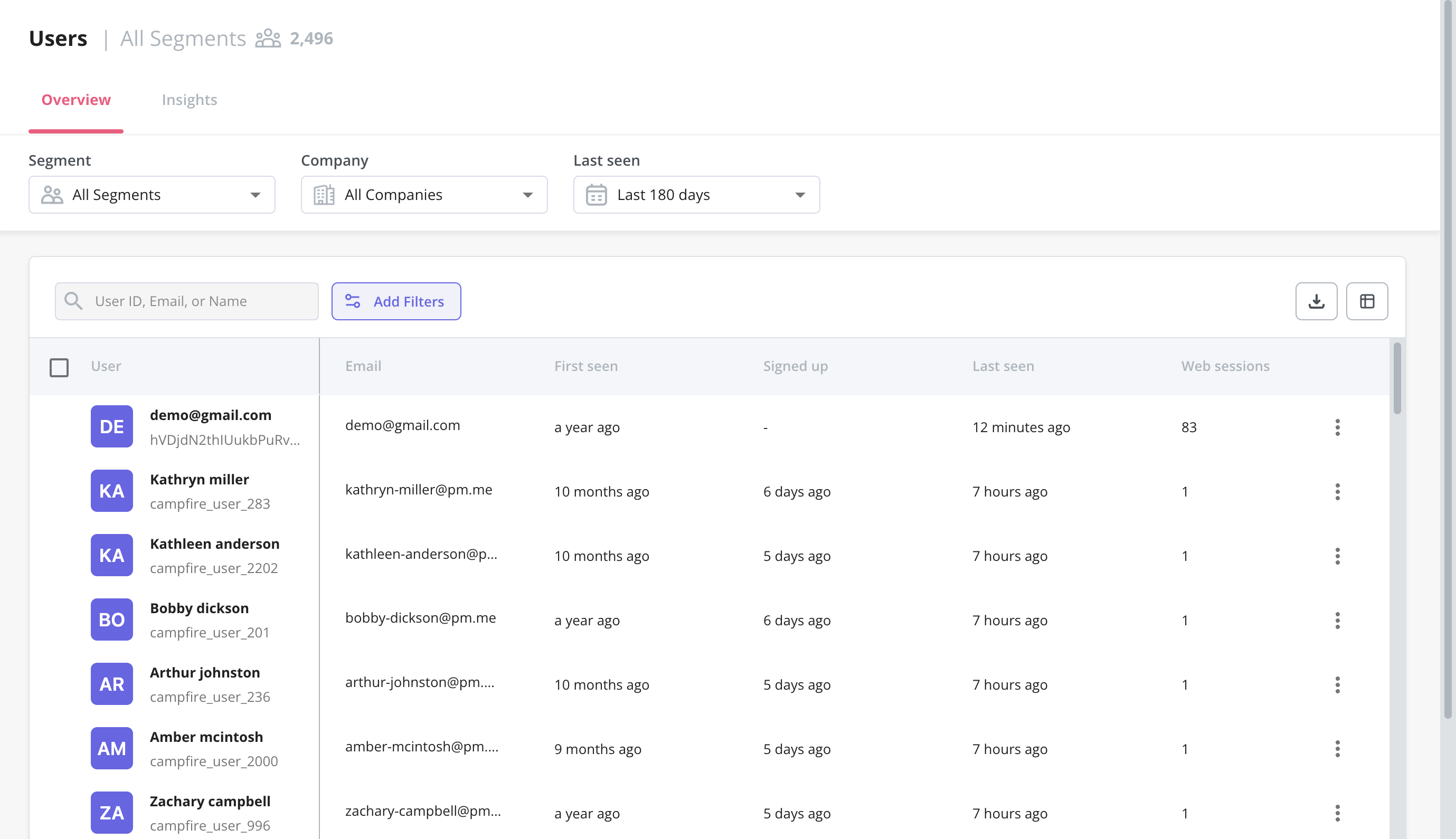
- Trends and funnels: Userpilot’s trends and funnels reports let you track certain events like a specific feature’s usage, add filters to narrow down the data, and then create a breakdown based on segmentation data or user attributes — offering quick and actionable CX reports.

- Satisfaction benchmarking: Userpilot has a built-in NPS dashboard that tracks customer loyalty over time. In addition to the NPS dashboard, you can also use Userpilot’s survey templates to run CSAT or CES surveys and gather additional quantitative and qualitative insights on the customer experience.
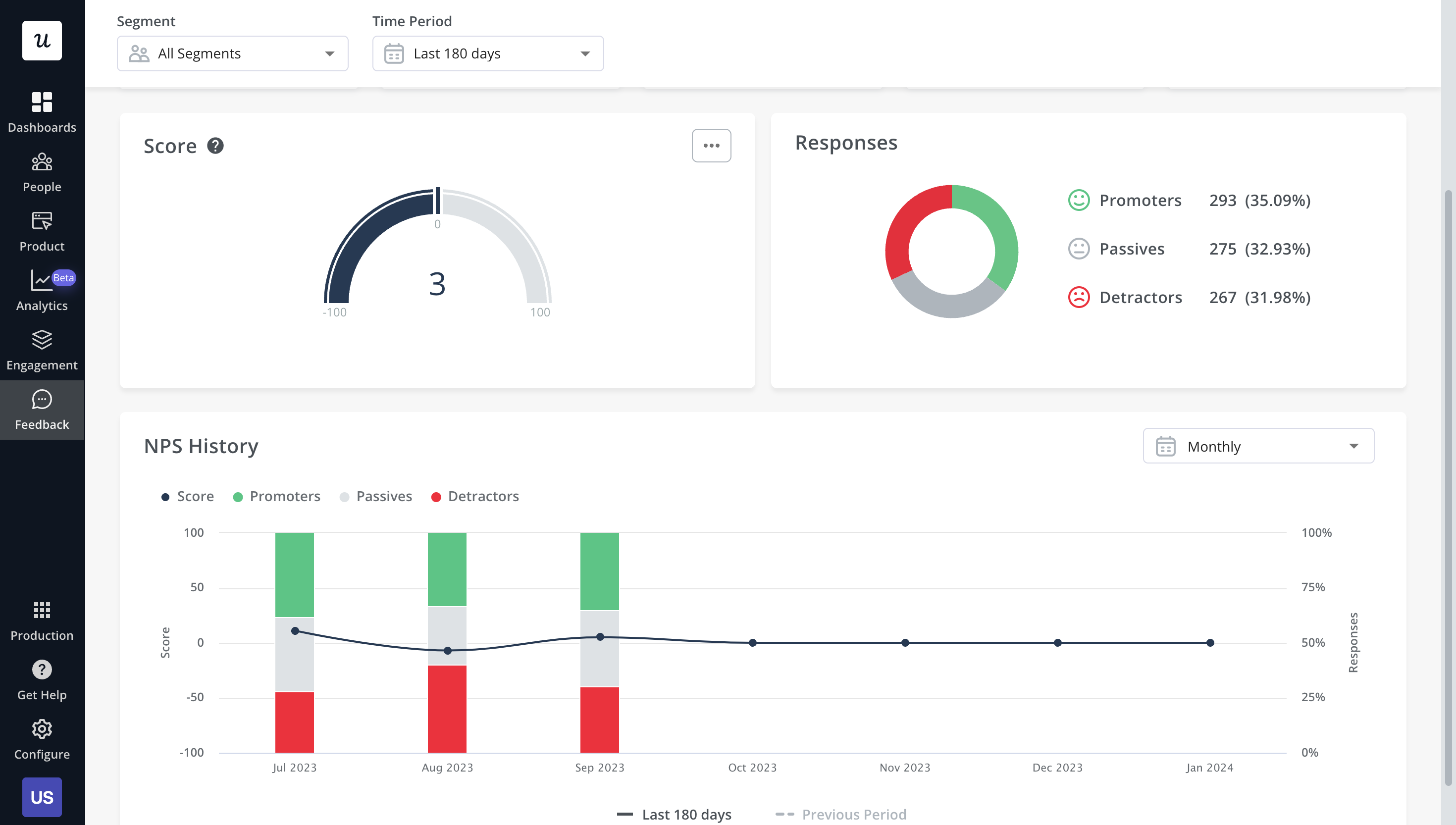
- Self-service support: Userpilot lets you build in-app resource centers, which can include feedback widgets to collect feedback passively, checklists to walk users through specific processes, or integrations with knowledge bases to leverage existing documentation.

- In-app flows: Userpilot’s no-code flow builder helps you create product experiences that can help you optimize the customer experience by educating customers and reducing their time-to-value (TTV). All UI patterns are available on every Userpilot plan from Starter to Enterprise.

Product Fruits for customer experience
Customer experience is all about ensuring a smooth and hassle-free interaction when using the product or service.
Now, how exactly can Product Fruits ramp up your customer experience?
- Dashboard: This feature enables you to monitor user onboarding progress and critically evaluate your onboarding strategies’ effectiveness.
- Feedback Management: This is a systematic process that involves collecting, tracking, and analyzing customer feedback. Product Fruits does this by offering useful tools like the Adoption Meter and the Feedback Widget to gauge customer sentiments and identify potential issues. You can submit these issues in the form of images or videos. The platform also provides NPS Surveys to assess customer loyalty over time. These insights drive continuous improvements in products and services and enhance the overall customer experience.
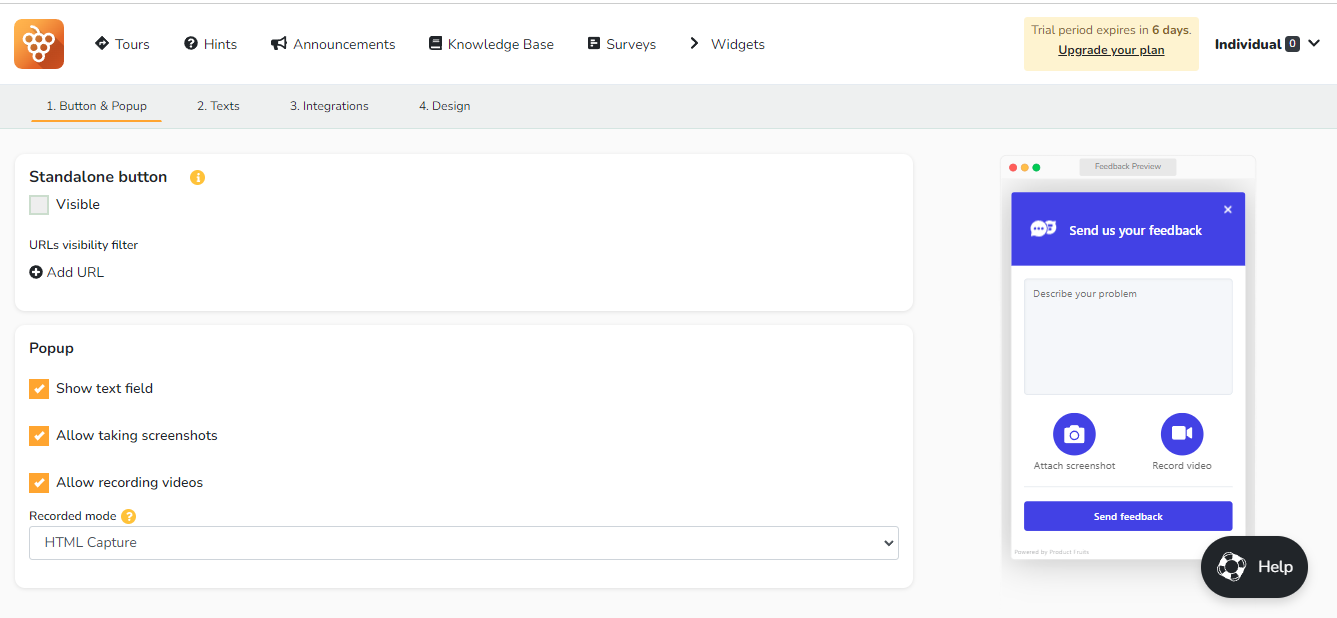
- Knowledge Base: This is a collection of helpful information that users can access whenever they need help. You can quickly get to your knowledge base articles through the Life Ring Button or a Hint icon. Moreover, Product Fruits offers an easy-to-use WYSIWYG editor that makes creating content easy.
Userpilot vs Product Fruits for user feedback
In this section of the article, we’re really going to compare Userpilot vs Product Fruits in terms of user feedback. That way, we’ll be able to figure out which tool – Userpilot or Product Fruits – is the best option depending on your use case.
Userpilot for user feedback
User feedback is an essential part of listening to the Voice of the Customer (VoC) and making product development or marketing decisions that best suit your customer base. Userpilot has a no-code survey builder, 14 templates to choose from, and advanced analytics for extracting insights.
Here are the Userpilot features you can use to collect customer feedback and analyze it:
- Survey builder: Userpilot’s survey builder lets you edit the content, update the widget’s style/placement, and set page-specific or event-specific triggers to ensure that users see the survey at the most contextual moment — all without writing a single line of code. You can also translate surveys into your audience’s native language.

- Survey templates: There are 14 survey templates to choose from with a wide array of different use cases. You can collect qualitative responses on how to improve the user/product experience or quantitative data for customer satisfaction benchmarking such as CSAT and CES scores.
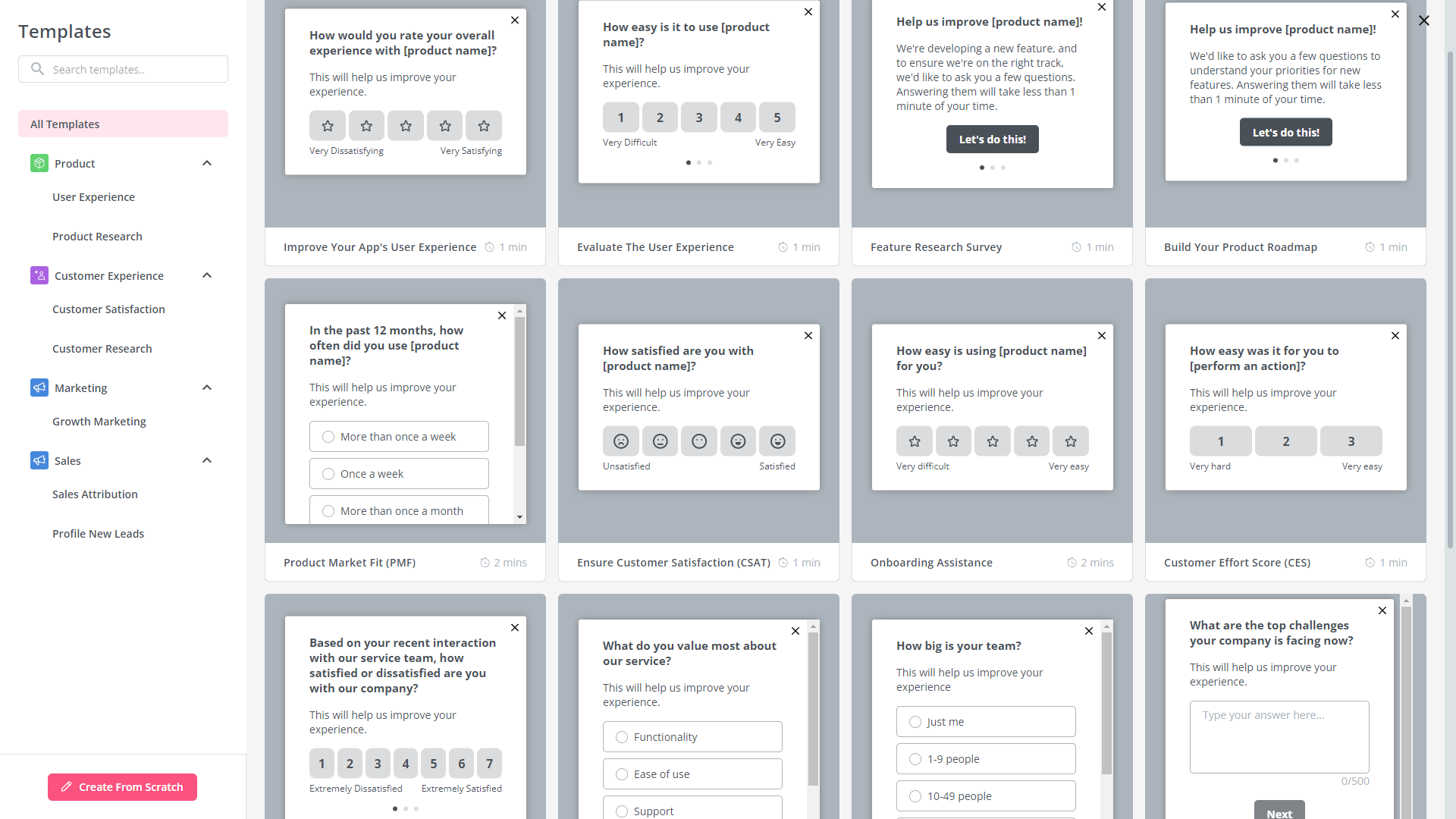
- Advanced analytics: Userpilot’s advanced survey analytics will show you what the most common responses were, what percentage of users selected a specific option, and display open-ended feedback about your product or specific features.
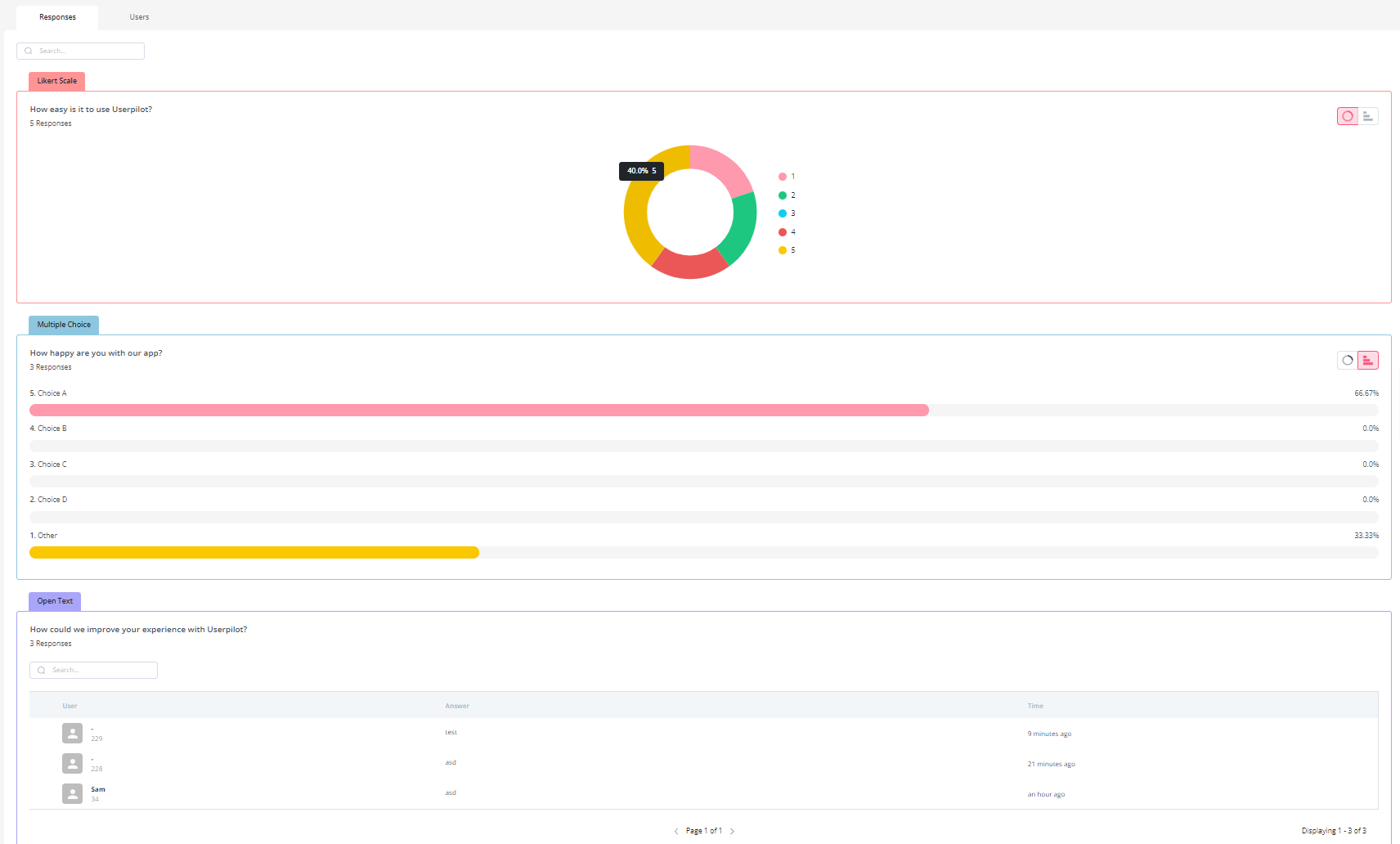
- NPS dashboard: Userpilot’s NPS dashboard compiles response data from all NPS surveys so you don’t have to manually go into each survey and check its analytics. You’ll be able to view key metrics like response rates, total views, and NPS history and sort all the data by different segments.

Product Fruits for user feedback
User feedback is the lifeblood of product development and enhancement. It guides businesses toward what their customers desire and value in a product.
Product Fruits gathers feedback in the following ways:
- Adoption Meter: This is a small tool with five emojis and a spot for comments. It helps you see how users feel about your product.
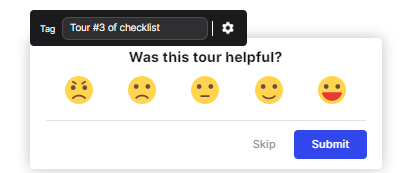
- Feedback Widget: Allows users to point out bugs through videos and images.
- In-app microsurveys: Surveys help collect valuable user feedback. With Product Fruits, you can create “Small” or “Large” surveys from scratch or use pre-built templates for efficiency. The templates include: You can create NPS surveys, churn surveys and CSAT surveys.
- Product Ratings: Allows user-generated ratings and reviews, highlighting the product’s strengths and weaknesses.
However, unlike Userpilot, Product Fruits does not offer survey analytics or a detailed NPS dashboard to make data-driven decisions.
Userpilot vs Product Fruits: Which one you should choose?
To further simplify this selection process, let’s break down the strengths and limitations of each tool. Understanding the distinct advantages and potential drawbacks of Userpilot and Product Fruits will provide you with a detailed roadmap for making a well-informed decision!
Pros and cons of Userpilot
Pros of Userpilot
As a full-suite digital adoption platform, Userpilot has all the features you need to onboard users, track analytics, and gather feedback from customers without writing a single line of code. Here are a few pros of using Userpilot as your product growth solution:
- No-code builder: Userpilot’s Chrome extension lets you build flows, add UI elements, and tag features without writing a single line of code.
- UI patterns: There are plenty of UI patterns to choose from when using Userpilot, such as hotspots, tooltips, banners, slideouts, modals, and more!
- Startup-friendly: Userpilot’s entry-level plan gives you access to all available UI patterns so you can hit the ground running.
- Walkthroughs and flows: Build engaging interactive walkthroughs and personalized onboarding flows that target specific segments of your user base.
- Self-service support: Build an in-app resource center to help users solve problems, customize its appearance to align it with your brand, and insert various types of content (videos, flows, or chatbots) to keep your customers satisfied.
- A/B testing: Userpilot’s built-in A/B testing capabilities will help you split-test flows, iterate on the best-performing variants, and continually optimize based on user behavior.
- Feedback collection: Userpilot has built-in NPS surveys with its own unified analytics dashboard and response tagging to help you retarget users. There are other survey types to choose from and you can even create your own custom survey.
- Survey templates: There are 14 survey templates to choose from so you can gather feedback on specific features or run customer satisfaction benchmarking surveys like CSAT and CES.
- Advanced analytics: Userpilot lets you analyze product usage data, monitor engagement on all in-app flows, and use the data to create user segments that are based on behaviors instead of demographics.
- Event tracking: Userpilot’s no-code event tracking lets you tag UI interactions (hovers, clicks, or form fills) and group them into a custom event that reflects feature usage.
- Third-party integrations: Userpilot has built-in integrations with tools like Amplitude, Mixpanel, Kissmetrics, Segment, Heap, HubSpot, Intercom, Google Analytics, and Google Tag Manager so you can share data between all the solutions in your tech stack.
Cons of Userpilot
Of course, no tool is perfect and there are a few cons to consider before choosing Userpilot as your user onboarding or product growth solution:
- Employee onboarding: Currently, Userpilot only supports in-app customer onboarding.
- Mobile apps: Userpilot doesn’t have any mobile compatibility which could make it difficult for developers with cross-platform applications to create a consistent user experience for both versions of their product.
- Freemium plan: There’s no freemium Userpilot plan so those bootstrapping their startup and need sub-$100 solutions should consider more affordable onboarding platforms like UserGuiding or Product Fruits.
Pros and cons of Product Fruits
Pros of Product Fruits
Product Fruits offers many benefits with its easy-to-use, no-code platform. It is one of the good solutions for companies looking for affordable user onboarding, product adoption, and product analytics.
So, what does Product Fruits bring to the table? Let’s explore its promising pros:
- Guided Product Tours: It guides users to learn about your app through step-by-step tours for new features.
- Newsfeed: Enhance your users’ connectivity by sharing updates about your product. Additionally, you can set specific newsfeed items which will be displayed in the knowledge base.
- Feedback Through Screenshots and Videos: This feature allows users to send screenshots or videos directly within the app to provide feedback.
- Tooltips: These are brief hints added to different parts of the application to guide users and prevent confusion
- Life Ring Button: A comprehensive support hub that combines all guidance and support resources in one location. This allows users to conveniently access onboarding flows, support documents, and tutorials, no matter what page they’re on.
- Custom Events: Trigger actions based on what users do in your app for more personal interaction.
- Segmentation: Create unique experiences for different types of users and show tailored content to separate user groups.
- Analytics: Gain valuable insights into user behavior, identify improvement areas, and address pain points effectively.
- AI Writer: This feature instantly generates your onboarding copy. However, it is only available in higher-tier plans.
Cons of Product Fruits
While Product Fruits does have its merits, it’s not without its share of issues. Let’s see some potential drawbacks that might have you considering alternatives.
- Absence of A/B Testing: Product Fruits lacks A/B testing, a vital feature for refining your product tours based on user responses and data-backed insights.
- Basic Analytics: Product Fruits does not offer in-depth analytics as its competitors like Userpilot. This makes it difficult to evaluate user interaction and the success of your onboarding
- Insufficient Segmentation Options: The segmentation options here are only based on user attributes. This means you can’t highlight particular app functions or experiences based on a user’s past actions in your app, which can limit the customization of their experience.
- Missing Event-Based Triggering: The absence of real-time triggers may limit timely content delivery. This could affect the success of all in-app flows, such as product tours, tooltips, walkthroughs, modals, etc.
- Complex Tour Configuration: Configuring tours with specific conditions, especially when tuning CSS selectors, can be challenging and time-consuming.
- Limited Integrations: This tool links up with analytic tools, which is great. However, it doesn’t go beyond that. You won’t be able to bring in your resource center materials or link up your CRM unless you’re a Hubspot user.
Userpilot vs Product Fruits – Why Userpilot might be a better choice?
 While both Userpilot and Product Fruits offer commendable user experience and engagement, Userpilot tends to shine a bit brighter in several key areas. Here’s why:
While both Userpilot and Product Fruits offer commendable user experience and engagement, Userpilot tends to shine a bit brighter in several key areas. Here’s why:
- A/B testing: Data-driven decisions, customer engagement, and conversion rate optimization are all outcomes of effective A/B testing. While Product Fruits leverages Google Optimize for its A/B testing, Userpilot integrates this functionality directly within the app. This approach not only simplifies the process but also enhances accessibility.
- Tailored checklists and knowledge base: Userpilot allows users to create customized checklists and knowledge bases. These can be tailored to different customer segments and stages in the customer journey. This offers a depth of personalization that Product Fruits lacks.
- Advanced Segmentation: Userpilot allows you to build multi-language flows using its AI-powered translation service, and there’s no limit on the number of users you can segment. It allows for more effective feedback collection through trigger surveys tied to user journey milestones, and NPS surveys for measuring product sentiment. You can also track how users are behaving within the app and group them accordingly. So, if someone hasn’t completed their onboarding, you can send a personalized in-app message to help them along. While Product Fruits provides basic user-specific segmentation, it lacks the comprehensive and contextual capabilities of Userpilot.
- Integrations: Both Product Fruits and Userpilot offer 9 integrations. Although, they do share some common integrations like Intercom, Mixpanel, and HubSpot. However, the integration of Slack and Userpilot is currently under development. Most integrated products within the same category carry out similar tasks, no matter what specific tool you opt for. For example, Userpilot has an in-app integrated product analytics tool, unlike Product Fruits. This tool boasts features similar to those found in other tools, like graph and funnel creation, and more.
- Advanced analytics: In the realm of analytics, Userpilot truly stands out. You’ll be able to deeply understand user behavior and sentiment, without fussing over coding or API calls. Your selected features can be tagged for precise tracking, no dev team is required. Curious about user actions like button clicks or purchases? Userpilot’s heatmap offers insight into your users’ most and least interacted areas. Unlike Product Fruits, Userpilot lets you monitor your checklists’ effectiveness live, transforming raw data into actionable insights.
Conclusion
Hopefully, this post helped you decide whether Userpilot or Product Fruits is more appropriate for your company. As you can see – both have many upsides and downsides.
However, Userpilot provides a better value for money and is a better choice for a mid-market SaaS, especially when it comes to user onboarding and user feedback.
If you’re interested in finding more, book a demo with our team here!
![]()
Try Userpilot – The Best User Onboarding Solution for SaaS


